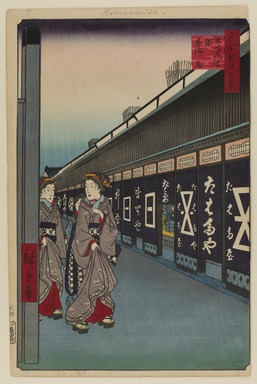
Artist:Utagawa Hiroshige
Medium: Woodblock print
Geograhical Locations:
Dates:4th month of 1858
Dimensions: Image: 13 3/8 x 9 in. (34 x 22.9 cm) Sheet: 14 1/8 x 9 1/4 in. (35.9 x 23.5 cm)
Collections:
Exhibitions:
Accession Number: 30.1478.7
Image: 30.1478.7_PS20.jpg,
Catalogue Description: It is evening and two Geisha and their young attendant (a Kabura or Kamuro) walk along the long stretch of cotton cloth and dry goods shops in Odenma-cho, popularly known as "Momendana" ("cotton shops"), in the heart of the city. Today it still is the cloth and cotton district of Tokyo. Beyond the shop curtain (Noren) of the Tamuraya store (center right) two merchants sit among piles of cotton fabric, probably tallying up the day's profits. The two Geisha in matched ensemble, returning from an evening providing samisen entertainment, perhaps at a wealthy wholesaler's home nearby. There is a disarray in their dress possibly hinting of the drink they may have shared with their customers. The attendant or servant who follows just behind has an arched eyebrow, perhaps conveying a sense of concern over her mistresses' condition. The architecture is typical is Odenma-cho and unusual for wealthy Edo merchants, since it enclosed a row of several different shops under a single roof - a house form normally reserved for backstreet tenements. In this print, the alternating names and crests identify three separate establishments: the Tabataya to the right, Masuya in the center and Shimaya in the distance. The three enclosures on the roof of the building are barrels to collect rain water to be used in case of fire.